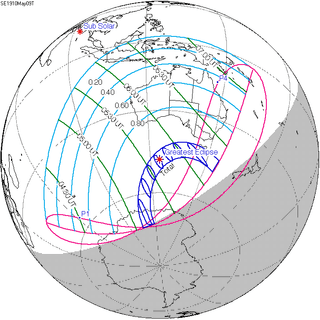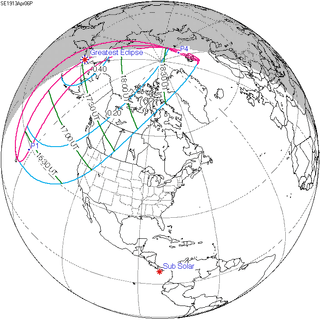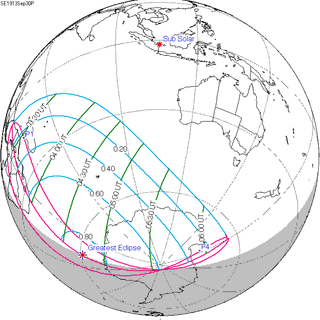Solar eclipse of November 2, 1910
A partial solar eclipse occurred on November 2, 1910. A solar eclipse occurs when the Moon passes between Earth and the Sun, thereby totally or partly obscuring the image of the Sun for a viewer on Earth. A partial solar eclipse occurs in the polar regions of the Earth when the center of the Moon's shadow misses the Earth.
| Solar eclipse of November 2, 1910 | |
|---|---|
 Map | |
| Type of eclipse | |
| Nature | Partial |
| Gamma | 1.0603 |
| Magnitude | 0.8515 |
| Maximum eclipse | |
| Coordinates | 61.9°N 155.1°W |
| Times (UTC) | |
| Greatest eclipse | 2:08:32 |
| References | |
| Saros | 122 (52 of 70) |
| Catalog # (SE5000) | 9305 |
Related eclipses
Solar eclipses of 1910–1913
This eclipse is a member of a semester series. An eclipse in a semester series of solar eclipses repeats approximately every 177 days and 4 hours (a semester) at alternating nodes of the Moon's orbit.[1]
| Solar eclipse series sets from 1910–1913 | ||||
|---|---|---|---|---|
| Ascending node | Descending node | |||
| 117 | May 9, 1910 Total |
122 | November 2, 1910 Partial | |
| 127 | April 28, 1911 Total |
132 | October 22, 1911 Annular | |
| 137 | April 17, 1912 Hybrid |
142 | October 10, 1912 Total | |
| 147 | April 6, 1913 Partial |
152 | September 30, 1913 Partial | |
gollark: Actually, GTech™ is at least 7+5i steps ahead at all times.
gollark: This sort of thing would be really annoying if we didn't just assemble water from apions on demand anyway.
gollark: Bee teleportation is a trivial application of some recent theorems in quantized apionics.
gollark: Counterhypermetabees you then!
gollark: I control Macron. Also, consider the following:
References
- van Gent, R.H. "Solar- and Lunar-Eclipse Predictions from Antiquity to the Present". A Catalogue of Eclipse Cycles. Utrecht University. Retrieved 6 October 2018.
External links
- Earth visibility chart and eclipse statistics Eclipse Predictions by Fred Espenak, NASA/GSFC
This article is issued from Wikipedia. The text is licensed under Creative Commons - Attribution - Sharealike. Additional terms may apply for the media files.
.jpg)
